Guoping Wang
NAT: Neural Acoustic Transfer for Interactive Scenes in Real Time
Jun 06, 2025Abstract:Previous acoustic transfer methods rely on extensive precomputation and storage of data to enable real-time interaction and auditory feedback. However, these methods struggle with complex scenes, especially when dynamic changes in object position, material, and size significantly alter sound effects. These continuous variations lead to fluctuating acoustic transfer distributions, making it challenging to represent with basic data structures and render efficiently in real time. To address this challenge, we present Neural Acoustic Transfer, a novel approach that utilizes an implicit neural representation to encode precomputed acoustic transfer and its variations, allowing for real-time prediction of sound fields under varying conditions. To efficiently generate the training data required for the neural acoustic field, we developed a fast Monte-Carlo-based boundary element method (BEM) approximation for general scenarios with smooth Neumann conditions. Additionally, we implemented a GPU-accelerated version of standard BEM for scenarios requiring higher precision. These methods provide the necessary training data, enabling our neural network to accurately model the sound radiation space. We demonstrate our method's numerical accuracy and runtime efficiency (within several milliseconds for 30s audio) through comprehensive validation and comparisons in diverse acoustic transfer scenarios. Our approach allows for efficient and accurate modeling of sound behavior in dynamically changing environments, which can benefit a wide range of interactive applications such as virtual reality, augmented reality, and advanced audio production.
SAIP-Net: Enhancing Remote Sensing Image Segmentation via Spectral Adaptive Information Propagation
Apr 23, 2025Abstract:Semantic segmentation of remote sensing imagery demands precise spatial boundaries and robust intra-class consistency, challenging conventional hierarchical models. To address limitations arising from spatial domain feature fusion and insufficient receptive fields, this paper introduces SAIP-Net, a novel frequency-aware segmentation framework that leverages Spectral Adaptive Information Propagation. SAIP-Net employs adaptive frequency filtering and multi-scale receptive field enhancement to effectively suppress intra-class feature inconsistencies and sharpen boundary lines. Comprehensive experiments demonstrate significant performance improvements over state-of-the-art methods, highlighting the effectiveness of spectral-adaptive strategies combined with expanded receptive fields for remote sensing image segmentation.
HUG: Hierarchical Urban Gaussian Splatting with Block-Based Reconstruction
Apr 23, 2025Abstract:As urban 3D scenes become increasingly complex and the demand for high-quality rendering grows, efficient scene reconstruction and rendering techniques become crucial. We present HUG, a novel approach to address inefficiencies in handling large-scale urban environments and intricate details based on 3D Gaussian splatting. Our method optimizes data partitioning and the reconstruction pipeline by incorporating a hierarchical neural Gaussian representation. We employ an enhanced block-based reconstruction pipeline focusing on improving reconstruction quality within each block and reducing the need for redundant training regions around block boundaries. By integrating neural Gaussian representation with a hierarchical architecture, we achieve high-quality scene rendering at a low computational cost. This is demonstrated by our state-of-the-art results on public benchmarks, which prove the effectiveness and advantages in large-scale urban scene representation.
Instance-Adaptive Keypoint Learning with Local-to-Global Geometric Aggregation for Category-Level Object Pose Estimation
Apr 21, 2025Abstract:Category-level object pose estimation aims to predict the 6D pose and size of previously unseen instances from predefined categories, requiring strong generalization across diverse object instances. Although many previous methods attempt to mitigate intra-class variations, they often struggle with instances exhibiting complex geometries or significant deviations from canonical shapes. To address this challenge, we propose INKL-Pose, a novel category-level object pose estimation framework that enables INstance-adaptive Keypoint Learning with local-to-global geometric aggregation. Specifically, our approach first predicts semantically consistent and geometric informative keypoints through an Instance-Adaptive Keypoint Generator, then refines them with: (1) a Local Keypoint Feature Aggregator capturing fine-grained geometries, and (2) a Global Keypoint Feature Aggregator using bidirectional Mamba for structural consistency. To enable bidirectional modeling in Mamba, we introduce a Feature Sequence Flipping strategy that preserves spatial coherence while constructing backward feature sequences. Additionally, we design a surface loss and a separation loss to enforce uniform coverage and spatial diversity in keypoint distribution. The generated keypoints are finally mapped to a canonical space for regressing the object's 6D pose and size. Extensive experiments on CAMERA25, REAL275, and HouseCat6D demonstrate that INKL-Pose achieves state-of-the-art performance and significantly outperforms existing methods.
Neural-Polyptych: Content Controllable Painting Recreation for Diverse Genres
Sep 29, 2024
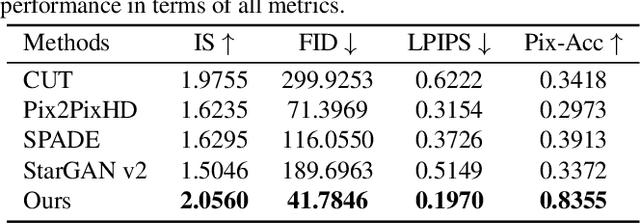


Abstract:To bridge the gap between artists and non-specialists, we present a unified framework, Neural-Polyptych, to facilitate the creation of expansive, high-resolution paintings by seamlessly incorporating interactive hand-drawn sketches with fragments from original paintings. We have designed a multi-scale GAN-based architecture to decompose the generation process into two parts, each responsible for identifying global and local features. To enhance the fidelity of semantic details generated from users' sketched outlines, we introduce a Correspondence Attention module utilizing our Reference Bank strategy. This ensures the creation of high-quality, intricately detailed elements within the artwork. The final result is achieved by carefully blending these local elements while preserving coherent global consistency. Consequently, this methodology enables the production of digital paintings at megapixel scale, accommodating diverse artistic expressions and enabling users to recreate content in a controlled manner. We validate our approach to diverse genres of both Eastern and Western paintings. Applications such as large painting extension, texture shuffling, genre switching, mural art restoration, and recomposition can be successfully based on our framework.
Neural Laplacian Operator for 3D Point Clouds
Sep 10, 2024Abstract:The discrete Laplacian operator holds a crucial role in 3D geometry processing, yet it is still challenging to define it on point clouds. Previous works mainly focused on constructing a local triangulation around each point to approximate the underlying manifold for defining the Laplacian operator, which may not be robust or accurate. In contrast, we simply use the K-nearest neighbors (KNN) graph constructed from the input point cloud and learn the Laplacian operator on the KNN graph with graph neural networks (GNNs). However, the ground-truth Laplacian operator is defined on a manifold mesh with a different connectivity from the KNN graph and thus cannot be directly used for training. To train the GNN, we propose a novel training scheme by imitating the behavior of the ground-truth Laplacian operator on a set of probe functions so that the learned Laplacian operator behaves similarly to the ground-truth Laplacian operator. We train our network on a subset of ShapeNet and evaluate it across a variety of point clouds. Compared with previous methods, our method reduces the error by an order of magnitude and excels in handling sparse point clouds with thin structures or sharp features. Our method also demonstrates a strong generalization ability to unseen shapes. With our learned Laplacian operator, we further apply a series of Laplacian-based geometry processing algorithms directly to point clouds and achieve accurate results, enabling many exciting possibilities for geometry processing on point clouds. The code and trained models are available at https://github.com/IntelligentGeometry/NeLo.
Learning the Geodesic Embedding with Graph Neural Networks
Sep 11, 2023Abstract:We present GeGnn, a learning-based method for computing the approximate geodesic distance between two arbitrary points on discrete polyhedra surfaces with constant time complexity after fast precomputation. Previous relevant methods either focus on computing the geodesic distance between a single source and all destinations, which has linear complexity at least or require a long precomputation time. Our key idea is to train a graph neural network to embed an input mesh into a high-dimensional embedding space and compute the geodesic distance between a pair of points using the corresponding embedding vectors and a lightweight decoding function. To facilitate the learning of the embedding, we propose novel graph convolution and graph pooling modules that incorporate local geodesic information and are verified to be much more effective than previous designs. After training, our method requires only one forward pass of the network per mesh as precomputation. Then, we can compute the geodesic distance between a pair of points using our decoding function, which requires only several matrix multiplications and can be massively parallelized on GPUs. We verify the efficiency and effectiveness of our method on ShapeNet and demonstrate that our method is faster than existing methods by orders of magnitude while achieving comparable or better accuracy. Additionally, our method exhibits robustness on noisy and incomplete meshes and strong generalization ability on out-of-distribution meshes. The code and pretrained model can be found on https://github.com/IntelligentGeometry/GeGnn.
6D-ViT: Category-Level 6D Object Pose Estimation via Transformer-based Instance Representation Learning
Oct 30, 2021



Abstract:This paper presents 6D-ViT, a transformer-based instance representation learning network, which is suitable for highly accurate category-level object pose estimation on RGB-D images. Specifically, a novel two-stream encoder-decoder framework is dedicated to exploring complex and powerful instance representations from RGB images, point clouds and categorical shape priors. For this purpose, the whole framework consists of two main branches, named Pixelformer and Pointformer. The Pixelformer contains a pyramid transformer encoder with an all-MLP decoder to extract pixelwise appearance representations from RGB images, while the Pointformer relies on a cascaded transformer encoder and an all-MLP decoder to acquire the pointwise geometric characteristics from point clouds. Then, dense instance representations (i.e., correspondence matrix, deformation field) are obtained from a multi-source aggregation network with shape priors, appearance and geometric information as input. Finally, the instance 6D pose is computed by leveraging the correspondence among dense representations, shape priors, and the instance point clouds. Extensive experiments on both synthetic and real-world datasets demonstrate that the proposed 3D instance representation learning framework achieves state-of-the-art performance on both datasets, and significantly outperforms all existing methods.
DeepEigen: Learning-based Modal Sound Synthesis with Acoustic Transfer Maps
Aug 17, 2021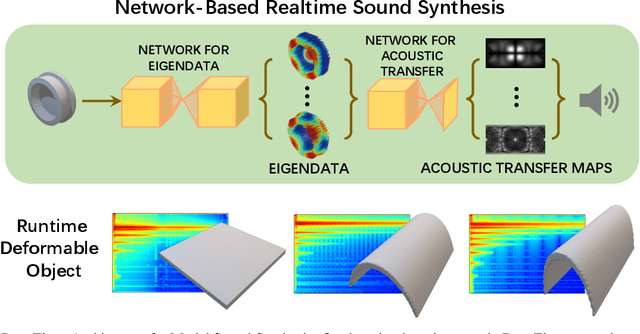
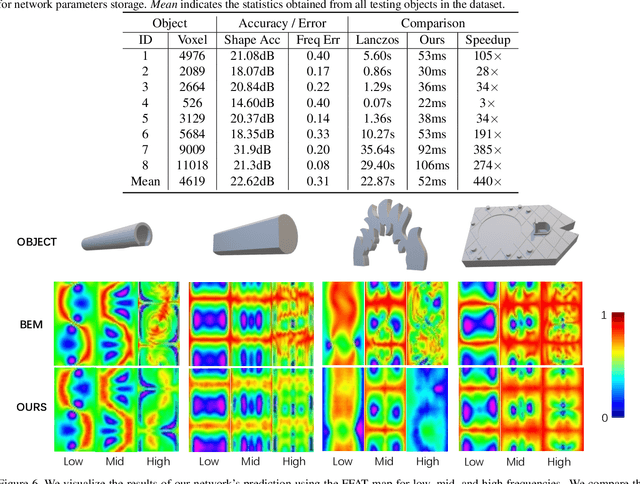
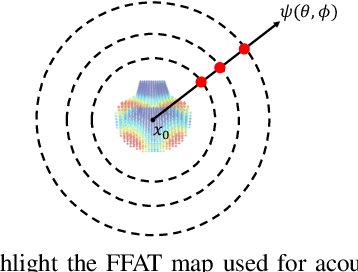
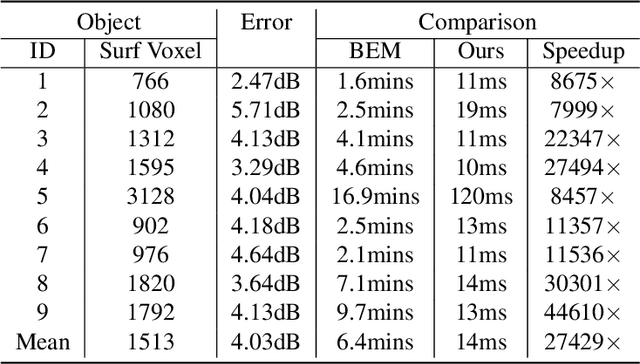
Abstract:We present a novel learning-based approach to compute the eigenmodes and acoustic transfer data for the sound synthesis of arbitrary solid objects. Our approach combines two network-based solutions to formulate a complete learning-based 3D modal sound model. This includes a 3D sparse convolution network as the eigendecomposition solver and an encoder-decoder network for the prediction of the Far-Field Acoustic Transfer maps (FFAT Maps). We use our approach to compute the vibration modes (eigenmodes) and FFAT maps for each mode (acoustic data) for arbitrary-shaped objects at interactive rates without any precomputed dataset for any new object. Our experimental results demonstrate the effectiveness and benefits of our approach. We compare its accuracy and efficiency with physically-based sound synthesis methods.
AA-RMVSNet: Adaptive Aggregation Recurrent Multi-view Stereo Network
Aug 09, 2021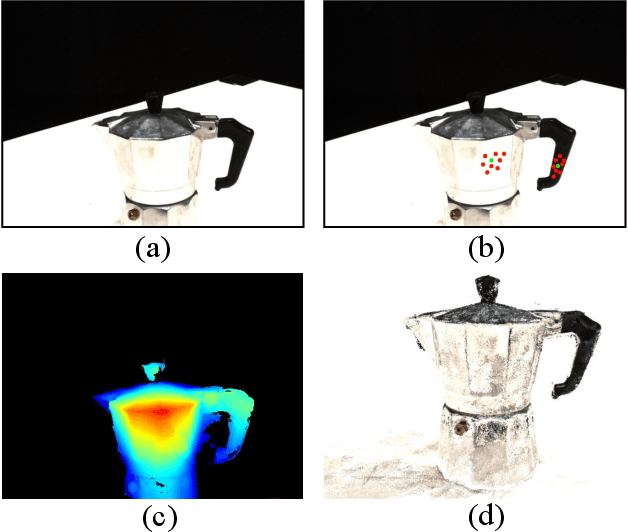
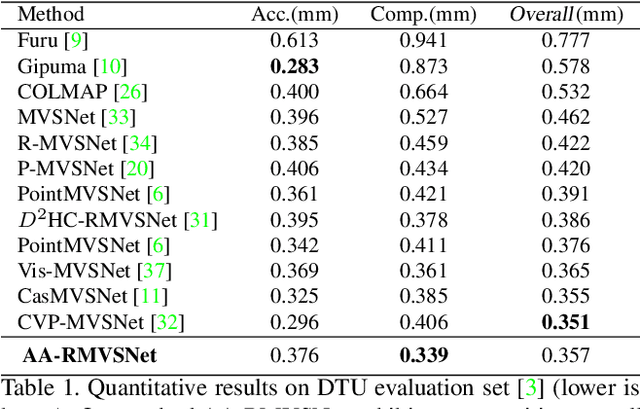
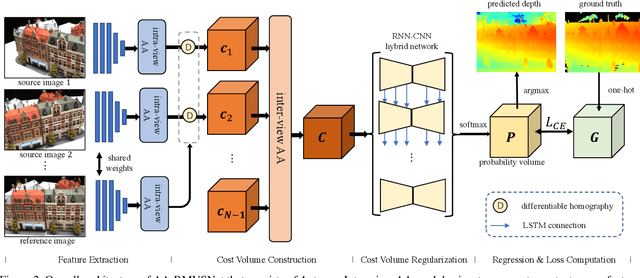
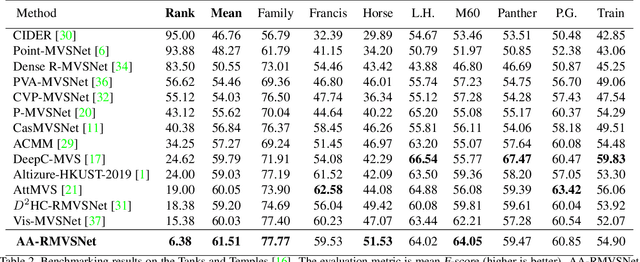
Abstract:In this paper, we present a novel recurrent multi-view stereo network based on long short-term memory (LSTM) with adaptive aggregation, namely AA-RMVSNet. We firstly introduce an intra-view aggregation module to adaptively extract image features by using context-aware convolution and multi-scale aggregation, which efficiently improves the performance on challenging regions, such as thin objects and large low-textured surfaces. To overcome the difficulty of varying occlusion in complex scenes, we propose an inter-view cost volume aggregation module for adaptive pixel-wise view aggregation, which is able to preserve better-matched pairs among all views. The two proposed adaptive aggregation modules are lightweight, effective and complementary regarding improving the accuracy and completeness of 3D reconstruction. Instead of conventional 3D CNNs, we utilize a hybrid network with recurrent structure for cost volume regularization, which allows high-resolution reconstruction and finer hypothetical plane sweep. The proposed network is trained end-to-end and achieves excellent performance on various datasets. It ranks $1^{st}$ among all submissions on Tanks and Temples benchmark and achieves competitive results on DTU dataset, which exhibits strong generalizability and robustness. Implementation of our method is available at https://github.com/QT-Zhu/AA-RMVSNet.
 Add to Chrome
Add to Chrome Add to Firefox
Add to Firefox Add to Edge
Add to Edge